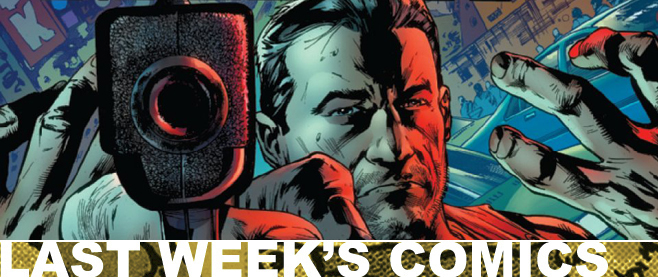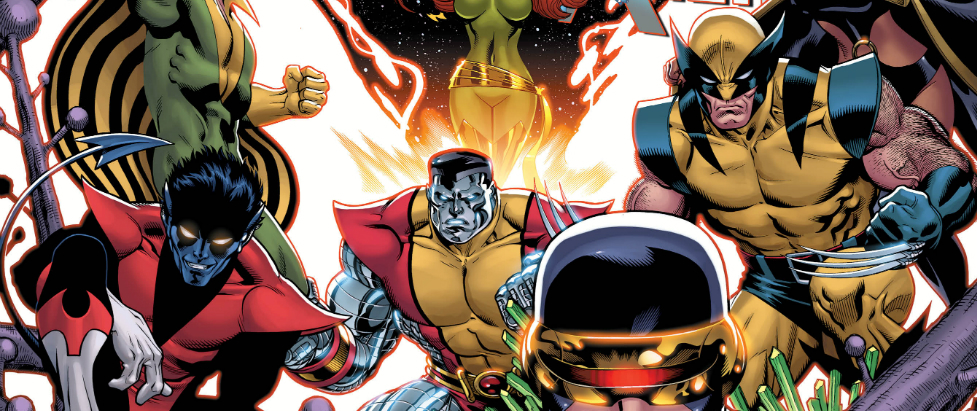
Last Week’s Comics 8/10/2011
[wpcol_1half id=”” class=”” style=””]
Severed #1

(Image – writers: Scott Snyder & Scott Tuft; art: Attila Futaki)
People often say they wish they could live in a simpler time. I’ve often thought about this as well. Things seem simpler in the early 20th century. People could reinvent themselves, move away to other places, and start new lives. Everything seemed easier.
Including murder.
Tonally, I think Severed is one of the best books I have ever read. It has stayed with me since I first read it, and I don’t think I’ve ever been more terrified by a comic character than I am by Mr. Porter.
I’ll backtrack. Severed is an in medias res story. We’re thrown into the 1950s, watching Elvis shake his hips on television. Then we’re introduced to Jack Garron, a one-armed grandfather who looks like an older version of William “D-FENS” Foster from Falling Down. But Jack Garron has an awful secret that is about to come to light.
Then, we’re thrown back to 1916 where a young Jack Garron is skipping town to reconnect with his traveling musician father. But this half of the story is not the really intriguing part of Severed. It’s when we’re introduced to Mr. Porter at St. Joseph’s Home for Boys that things get interesting.
Mr. Porter is an electrician for General Electric, and he’s looking for an apprentice, which is why he adopts Frederick. But there’s something off about Mr. Porter. He says things like, “We’re going to have some fun, Freddy,” and the entire time, I couldn’t shake the feeling that there was something wrong with this situation. But anybody would assume the same thing if an older man adopted an orphaned boy and drove him out on a dark night to a deserted house in a snow-covered field. And this is where the tone of the story changes.
Attila Futaki’s art works well to highlight the disconnect between how Mr. Porter acts, and how we perceive him. There are shots of leafless tree limbs and cold, barren fields. Porter himself is never centered in a frame. He’s always a little off, and often he’s contorted or misshapen to be more animalistic. If this doesn’t scare you, consider this exchange:
Freddy: How’d you get so tough?
Mr. Porter: Me? I was born this way. Behind these pearly whites, I got razor sharp teeth.
Freddy: HA! HA! HA! HA!
Mr. Porter: I’m serious, Freddy. These babies are all show. Underneath . . . my real ones are sharp as knives. But sales is all about appearances and it’s hard to sell anything if you look like a shark.
If I were Freddy, I would have shit my pants.
While Severed tells the story of Jack Garron, Mr. Porter is truly the most intriguing part of it. He’s a terrifying wolf in sheep’s clothing, and the last page is truly a work of art, for it’s been built up to all through the issue. I cannot wait to read issue two.
If you’re looking for a strong recommendation, go right now and pick up a copy of Severed. It’s a horrific story that’s brilliantly crafted by Snyder and Tuft, and Futaki’s art is so well suited for it that I have to give him the majority of the credit for the creepiness of the issue. I haven’t been so viscerally moved by a comic since Crossed, and while Crossed is a fucked-up series, it’s dependent on moral degeneracy and appalling imagery. Severed is more than that. It’s a series that’s offering hope on one hand, showing an expansive country of possibility, and on the other hand, leaving readers in the cold grip of a monster. I can’t get Severed out of my head, and I hope when you read it, you enjoy it the same way I did.
Just remember to sleep with the lights on afterward.
Mr. Porter likes the dark.
[/wpcol_1half] [wpcol_1half_end id=”” class=”” style=””]
Rachel Rising #1

(Abstract Studios – story and art: Terry Moore)
Terry Moore’s best-known work is The Strangers in Paradise, a series centered around two women who struggle with love, friendship, and political sabotage. I have to confess that I’ve never read the series, though I’ve always heard great things about it. From reading about Moore, he’s known as being a writer who’s sympathetic to female characters, often empowering them in ways that allow them to be more than sexualized individuals. Rachel Rising has a lot of the same elements as Moore’s other works, and while its initial delivery is slow and engaging, the end of the issue is like a door slamming in your face. It feels rushed, and anti-climactic. There’s a lot to like about Rachel Rising, but readers might feel a bit lost when they close the book. Or at least I did.
Rachel Rising starts out with dialogue-less pages – nine to be exact – that show a woman walking into the woods. She stands at an embankment, inhaling the clean forest air. Then the ground below her quivers, shifts slightly, and a hand emerges from the dirt.
Enter Rachel.
The book reads like a murder mystery, but the victim is still alive, albeit half-dead. Rachel has memories of being strangled (and rope burns around her neck to prove it), but she can’t remember anything beyond seeing her boyfriend a few days prior. Now she’s back, dressed in black, and her eyes have a weird shade to them.
The ink work in the issue is excellent. The lines are clean, and Moore does a great job of developing character through his illustrations. We only get two pages of real in-depth dialogue, which occurs between Rachel, her boyfriend Jet, and his manager Ray. I thought the back-and-forth between the characters painted Rachel as a sympathetic female, Jet as a dorky grease monkey, and Ray as a perverted older male.
But beyond that, we’re given a very abrupt conclusion to the first issue, one that really isn’t satisfying. I thought my issue was missing pages because of how abruptly it ended. And if I have to nit-pick at something else, it’d be that after Rachel wakes up (after sleeping for three straight days), she talks to herself about how she smells, and how she looks. It seems a bit contrived and unnecessary, considering that Moore didn’t need to do that in the introduction of the issue. He’s able to convey so much through his art, it seemed pointless to have Rachel tell the characters about her body odor or the paleness of her skin.
I’m intrigued enough to pick up a second issue, but if the conclusions are like the first issue, I may have a problem following the series. While most comics end on a cliffhanger, it’s a noticeable cliffhanger. Rachel Rising doesn’t do this, and if anything, it left me unsatisfied and confused.
Hopefully, this will be corrected in future issues because Rachel Rising has a lot to offer readers. Plus, in a world of oversaturated comic coloring, it’s nice to see simple black and white inks, especially when they’re done this well.
——–
[/wpcol_1half_end]


